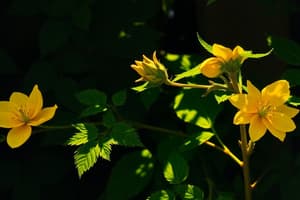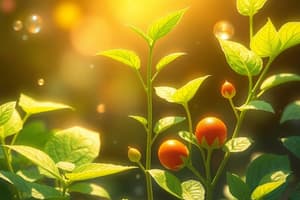Podcast
Questions and Answers
What is the main difference between autotrophic and heterotrophic modes of nutrition?
What is the main difference between autotrophic and heterotrophic modes of nutrition?
Autotrophic organisms produce their own food, while heterotrophic organisms obtain food by consuming other organisms or organic matter.
What is the overall equation for photosynthesis?
What is the overall equation for photosynthesis?
6CO2 + 6H2O + light energy → C6H12O6 (glucose) + 6O2
What is the primary difference between aerobic and anaerobic respiration?
What is the primary difference between aerobic and anaerobic respiration?
Aerobic respiration occurs in the presence of oxygen and produces ATP, while anaerobic respiration occurs in the absence of oxygen and produces lactic acid or ethanol.
What is the main function of the excretory system?
What is the main function of the excretory system?
What is the primary role of hormones in growth and development?
What is the primary role of hormones in growth and development?
What is one indication of life?
What is one indication of life?
What type of movement is observed in cilia?
What type of movement is observed in cilia?
What is the purpose of flagella in cells?
What is the purpose of flagella in cells?
What is muscle contraction an example of?
What is muscle contraction an example of?
What is one characteristic that distinguishes living things from non-living things?
What is one characteristic that distinguishes living things from non-living things?
Study Notes
Nutrition
- Nutrition is the process by which living organisms obtain and utilize energy and nutrients from their environment.
- Modes of nutrition:
- Autotrophic: organisms produce their own food using sunlight, water, and CO2 (e.g. plants, algae)
- Heterotrophic: organisms obtain food by consuming other organisms or organic matter (e.g. animals, fungi)
Photosynthesis
- Process by which green plants, algae, and some bacteria convert light energy into chemical energy
- Equation: 6CO2 + 6H2O + light energy → C6H12O6 (glucose) + 6O2
- Importance: produces oxygen, supports life on Earth, and provides energy for food chains
Respiration
- Process by which cells generate energy from glucose and other organic molecules
- Equation: C6H12O6 (glucose) + 6O2 → 6CO2 + 6H2O + ATP (energy)
- Types:
- Aerobic respiration: occurs in presence of oxygen, produces ATP
- Anaerobic respiration: occurs in absence of oxygen, produces lactic acid or ethanol
Transport
- Movement of materials within an organism or between organisms and their environment
- Types:
- Passive transport: diffusion, osmosis, facilitated diffusion
- Active transport: requires energy, involves carrier proteins and pumps
Excretion
- Process by which waste products are removed from an organism
- Types:
- Kidneys filter waste and excess ions from blood
- Liver detoxifies and removes toxins from blood
- Lungs expel CO2 and water vapor
- Skin and exocrine glands remove waste and excess salts
Coordination and Control
- Regulation of internal environment and responses to stimuli
- Types:
- Nervous system: integrates sensory information and responds to stimuli
- Endocrine system: produces and regulates hormones to control various bodily functions
Growth and Development
- Increase in size, complexity, and function of an organism
- Involves cell division, differentiation, and organization
- Regulated by hormones, genes, and environmental factors
Nutrition
- Nutrition is the process by which living organisms obtain and utilize energy and nutrients from their environment.
- There are two modes of nutrition: autotrophic and heterotrophic.
- Autotrophic organisms produce their own food using sunlight, water, and CO2, such as plants and algae.
- Heterotrophic organisms obtain food by consuming other organisms or organic matter, such as animals and fungi.
Photosynthesis
- Photosynthesis is the process by which green plants, algae, and some bacteria convert light energy into chemical energy.
- The equation for photosynthesis is: 6CO2 + 6H2O + light energy → C6H12O6 (glucose) + 6O2.
- Photosynthesis produces oxygen, supports life on Earth, and provides energy for food chains.
Respiration
- Respiration is the process by which cells generate energy from glucose and other organic molecules.
- The equation for respiration is: C6H12O6 (glucose) + 6O2 → 6CO2 + 6H2O + ATP (energy).
- There are two types of respiration: aerobic and anaerobic.
- Aerobic respiration occurs in the presence of oxygen and produces ATP.
- Anaerobic respiration occurs in the absence of oxygen and produces lactic acid or ethanol.
Transport
- Transport is the movement of materials within an organism or between organisms and their environment.
- There are two types of transport: passive and active.
- Passive transport includes diffusion, osmosis, and facilitated diffusion.
- Active transport requires energy and involves carrier proteins and pumps.
Excretion
- Excretion is the process by which waste products are removed from an organism.
- The kidneys filter waste and excess ions from the blood.
- The liver detoxifies and removes toxins from the blood.
- The lungs expel CO2 and water vapor.
- The skin and exocrine glands remove waste and excess salts.
Coordination and Control
- Coordination and control involve the regulation of internal environment and responses to stimuli.
- The nervous system integrates sensory information and responds to stimuli.
- The endocrine system produces and regulates hormones to control various bodily functions.
Growth and Development
- Growth and development involve an increase in size, complexity, and function of an organism.
- Growth and development involve cell division, differentiation, and organization.
- Growth and development are regulated by hormones, genes, and environmental factors.
Nutrition
- Nutrition involves obtaining and utilizing energy and nutrients from the environment.
- Autotrophic organisms produce their own food using sunlight, water, and CO2, examples include plants and algae.
- Heterotrophic organisms obtain food by consuming other organisms or organic matter, examples include animals and fungi.
Photosynthesis
- Green plants, algae, and some bacteria convert light energy into chemical energy through photosynthesis.
- The equation for photosynthesis is 6CO2 + 6H2O + light energy → C6H12O6 (glucose) + 6O2.
- Photosynthesis produces oxygen, supports life on Earth, and provides energy for food chains.
Respiration
- Cells generate energy from glucose and other organic molecules through respiration.
- The equation for respiration is C6H12O6 (glucose) + 6O2 → 6CO2 + 6H2O + ATP (energy).
- There are two types of respiration: aerobic respiration, which occurs in the presence of oxygen and produces ATP, and anaerobic respiration, which occurs in the absence of oxygen and produces lactic acid or ethanol.
Transport
- Transport involves the movement of materials within an organism or between organisms and their environment.
- There are two types of transport: passive transport, which includes diffusion, osmosis, and facilitated diffusion, and active transport, which requires energy and involves carrier proteins and pumps.
Excretion
- Excretion involves the removal of waste products from an organism.
- The kidneys filter waste and excess ions from the blood.
- The liver detoxifies and removes toxins from the blood.
- The lungs expel CO2 and water vapor.
- The skin and exocrine glands remove waste and excess salts.
Coordination and Control
- Coordination and control involve the regulation of internal environment and responses to stimuli.
- The nervous system integrates sensory information and responds to stimuli.
- The endocrine system produces and regulates hormones to control various bodily functions.
Growth and Development
- Growth and development involve an increase in size, complexity, and function of an organism.
- This process involves cell division, differentiation, and organization.
- Hormones, genes, and environmental factors regulate growth and development.
- Movement of various types can be taken as an indication of life.
Studying That Suits You
Use AI to generate personalized quizzes and flashcards to suit your learning preferences.
Description
Learn about the process of nutrition in living organisms, including autotrophic and heterotrophic modes, and the process of photosynthesis in plants and algae.




